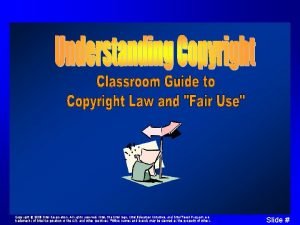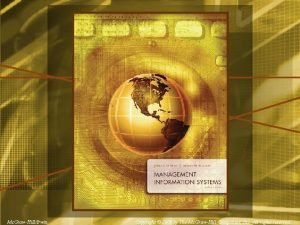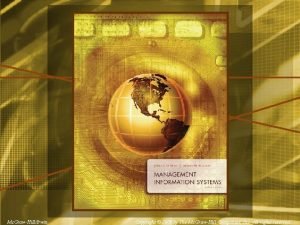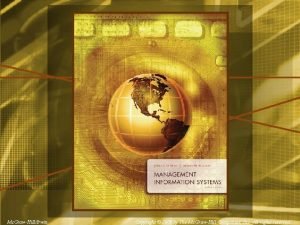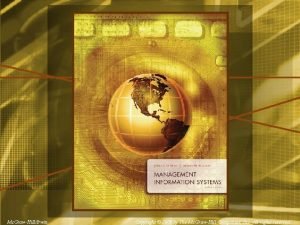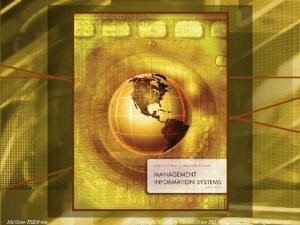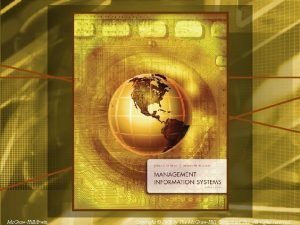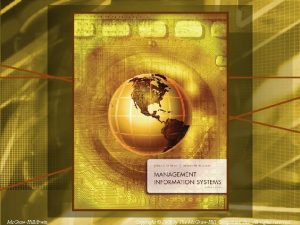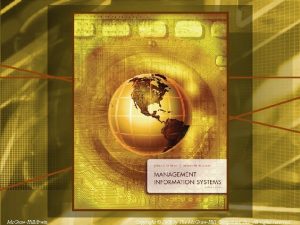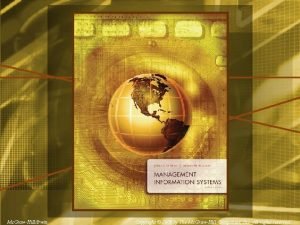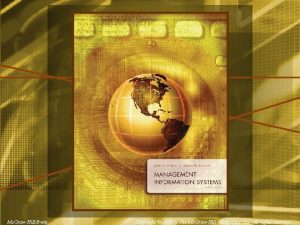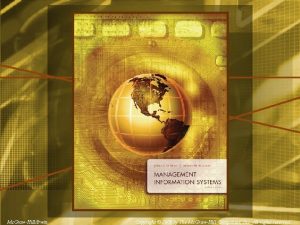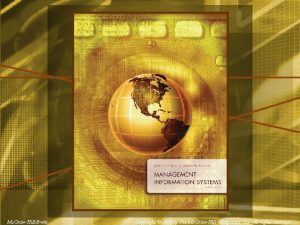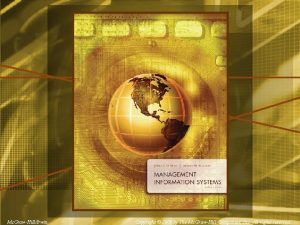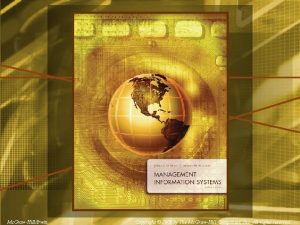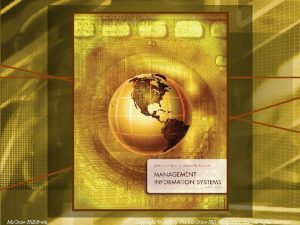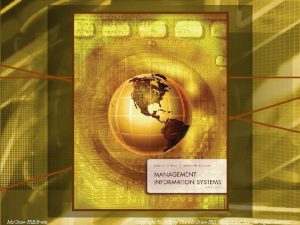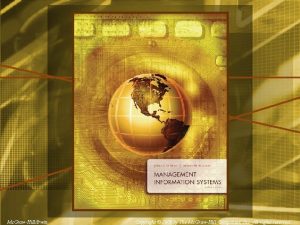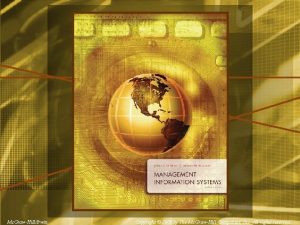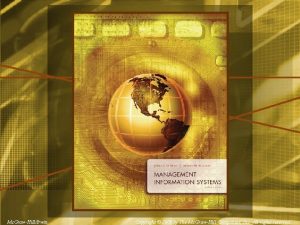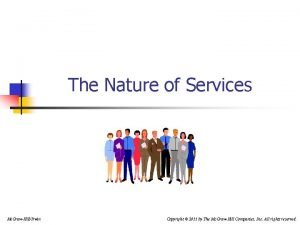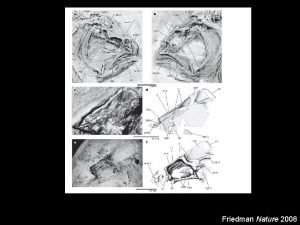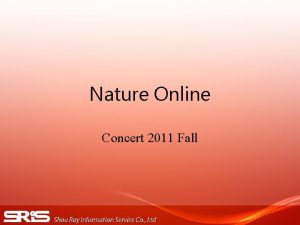The Nature of Services Mc GrawHillIrwin Copyright 2008


























- Slides: 26

The Nature of Services Mc. Graw-Hill/Irwin Copyright © 2008 by The Mc. Graw-Hill Companies, Inc. All rights reserved.

2 -2 Learning Objectives n n n n Explain what is meant by a service-product bundle. Identity and critique the five distinctive characteristics of a service operation and explain the implications for managers. Explain how services can be described as customers renting resources. Describe a service using the five dimensions of the service package. Use the service process matrix to classify a service. Explain how a strategic classification of services can be helpful to managers. Explain the role of a service manager from an opensystems view of service.

2 -3 Service-Product Bundle Element Business Core Goods Example Custom clothier Core Service Example Business hotel Core Business suits Room for the night Peripheral Goods Peripheral Service Variant Garment bag Bath robe Deferred payment plans In house restaurant Coffee lounge Airport shuttle

2 -4 Distinctive Characteristics of Services n n n Simultaneity: opportunities for personal selling, interaction creates customer perceptions of quality Perishability: cannot inventory, opportunity loss of idle capacity, need to match supply with demand Intangibility: creative advertising, no patent protection, importance of reputation Heterogeneity: customer involvement in delivery process results in variability Customer Participation in the Service Process: attention to facility design, opportunities for coproduction, concern for customer and employee behavior

2 -5 Non-ownership Classification of Services Type of Service Customer value Examples Management Challenge Goods rental Obtain temporary right to exclusive use Vehicles, tools, furniture, equipment Site selection and maintenance Place and space rental Obtain exclusive use of defined portion of a larger space Hotel room, seat on airplane, storage unit Housekeeping and achieving economies of scale Labor and expertise Hire other people to do a job Car repair, surgery, management consulting Expertise is a renewable resource, but time is perishable Physical facility usage Gain admission to a facility for a period of time Theme park, camp ground, physical fitness gym Queuing and crowd control Network usage Gain access to participate Electric utility, cell phone, internet Availability and pricing decisions

2 -6 Implications of Rental/Usage Paradigm n n n Creates the option of renting a good upon demand rather than purchase. Service often involves selling slices of larger physical entities. Labor and expertise are renewable resources. Time plays a central role in most services. Service pricing should vary with time and availability. Question: Can services in general be described as customers sharing resources?

2 -7 The Service Package n n n Supporting Facility: The physical resources that must be in place before a service can be sold. Examples are golf course, ski lift, hospital, airplane. Facilitating Goods: The material consumed by the buyer or items provided by the consumer. Examples are food items, legal documents, golf clubs, medical history. Information: Operations data or information that is provided by the customer to enable efficient and customized service. Examples are patient medical records, seats available on a flight, customer preferences, location of customer to dispatch a taxi.

2 -8 The Service Package (cont. ) n n Explicit Services: Benefits readily observable by the senses. The essential or intrinsic features. Examples are quality of meal, attitude of the waiter, on-time departure. Implicit Services: Psychological benefits or extrinsic features which the consumer may sense only vaguely. Examples are privacy of loan office, security of a well lighted parking lot.

2 -9 The Service Process Matrix Degree of labor Intensity Low High Degree of Interaction and Customization Low High Service Factory Service Shop * Airlines * Hospitals * Trucking * Auto repair * Hotels * Other repair services * Resorts and recreation Mass Service * Retailing * Wholesaling * Schools * Retail banking Professional Service * Doctors * Lawyers * Accountants * Architects

2 -10 Strategic Service Classification (Nature of the Service Act) Direct Recipient of the Service Nature of the Service Act Tangible actions People’s bodies: Health care Passenger transportation Freight transportation Repair and maintenance Beauty salons Exercise clinics Restaurants Veterinary care Janitorial services Laundry and dry cleaning People’s minds: Education Intangible actions Things Physical possessions: Broadcasting Information services Theaters Museums Intangible assets: Banking Legal services Accounting Securities Insurance

2 -11 Strategic Service Classification (Relationship with Customers) Type of Relationship between Service Organization and Its Customers Nature of Service Delivery Continuous delivery of service Discrete transactions “Membership” relationship No formal relationship Insurance Telephone subscription Radio station Police protection Electric Utility Lighthouse Banking Public Highway Long-distance phone calls Theater series tickets Restaurant Pay phone Transit pass Wholesale buying club Airline frequent flyer Toll highway Movie theater Public transportation

2 -12 Strategic Service Classification (Customization and Judgment) Degree of Customization Extent to Which Personnel Exercise Judgment in Meeting Customer Needs High Surgery Preventive health programs Taxi services Education (large classes) Family restaurant Gourmet restaurant Low Telephone service Hotel services Public transportation Spectator sports Retail banking Cafeteria Movie theater Institutional food service

Strategic Service Classification (Nature of Demand Capacity) Extent of Demand Fluctuation over Time Extent to Which Demand Exceeds Capacity Peak demand can met without a major delay Peak demand regularly exceeds capacity Wide Narrow Electricity Insurance Telephone Legal services Police emergency Hospital maternity unit Banking Laundry and dry cleaning Tax preparation Fast food restaurant Passenger transportation Hotels and motels Movie theater Gas station 2 -13

2 -14 Strategic Service Classification (Method of Service Delivery) Availability of Service Outlets Nature of Service Delivery Single site Multiple site Customer travels to service organization Theater Bus service Barbershop Fast-food chain Service firm delivers Taxi Pest control service Mail delivery AAA emergency repairs Credit card company Broadcast network Local TV station Telephone company Transaction at arm’s length

2 -15 Open Systems View of Services Consumer arrivals (input) Service Process Consumer Evaluation Consumer participant Consumer-Provider interface departures ( output) Criteria Measurement Control Customer demand Perceived needs Location Monitor Service operations manager Service personnel Production function: Alter Monitor and control process Schedule demand Marketing function: supply Interact with consumers Control demand Modify as necessary Define standard Service package Communicate by advertising Supporting facility Facilitating goods Explicit services Implicit services Basis of selection Empowerment Training Attitudes

2 -16 Village Volvo’s Service Package n Supporting Facility n Facilitating Goods n Information n Explicit Services n Implicit Services

2 -17 Village Volvo’s Distinctive Service Characteristics n Intangibility n Perishability n Heterogeneity n Simultaneity n Customer Participation in the Service Process

2 -18 Village Volvo’s Service Classification n Nature of the service act n Relationship with customers n Customization and judgement n Nature of demand supply n Method of service delivery

2 -19 Managing Village Volvo n n How could Village Volvo manage its back office (repair operations) like a factory? How can Village Volvo differentiate itself from Volvo dealers?

2 -20 Xpresso Lube Facility

2 -21 Xpresso Lube’s Service Package n Supporting Facility n Facilitating Goods n Information n Explicit Services n Implicit Services

2 -22 Xpresso Lube’s Distinctive Service Characteristics n Intangibility n Perishability n Heterogeneity n Simultaneity n Customer Participation in the Service Process

Xpresso Lube’s Service Classification n Nature of the service act n Relationship with customers n Customization and judgement n Nature of demand supply n Method of service delivery 2 -23

2 -24 Beyond Xpresso Lube n n What elements of Xpresso Lube’s location contribute to its success? Given the example of Xpresso Lube, what other services could be combined to “add value” for the customer?

2 -25 Topics for Discussion n n What are the characteristics of services that will be most appropriate for Internet delivery? When does collecting information through service membership become an invasion of privacy? What are some management problems associated with allowing service employees to exercise judgement in meeting customer needs? Illustrate the “distinctive characteristics of service operations” for a service with which you are familiar. What factors are important for a manager to consider when attempting to enhance a service firm’s image?

2 -26 Interactive Class Exercise The class breaks into five groups and each group is assigned one of the service classifications (e. g. , nature of act, relationship with customer, customization, nature of demand, or method of delivery) to come up with an example for each of the four quadrants in the matrix.
 2008 2008
2008 2008 Copyright 2008
Copyright 2008 Copyright 2008
Copyright 2008 Copyright 2008
Copyright 2008 Redistribution prohibited
Redistribution prohibited 2008 pearson prentice hall inc
2008 pearson prentice hall inc Copyright 2008
Copyright 2008 Copyright 2008
Copyright 2008 Nature and nature's law lay hid in night
Nature and nature's law lay hid in night Determinace lidské psychiky
Determinace lidské psychiky Hát kết hợp bộ gõ cơ thể
Hát kết hợp bộ gõ cơ thể Ng-html
Ng-html Bổ thể
Bổ thể Tỉ lệ cơ thể trẻ em
Tỉ lệ cơ thể trẻ em Chó sói
Chó sói Thang điểm glasgow
Thang điểm glasgow Alleluia hat len nguoi oi
Alleluia hat len nguoi oi Môn thể thao bắt đầu bằng từ chạy
Môn thể thao bắt đầu bằng từ chạy Thế nào là hệ số cao nhất
Thế nào là hệ số cao nhất Các châu lục và đại dương trên thế giới
Các châu lục và đại dương trên thế giới Cong thức tính động năng
Cong thức tính động năng Trời xanh đây là của chúng ta thể thơ
Trời xanh đây là của chúng ta thể thơ Cách giải mật thư tọa độ
Cách giải mật thư tọa độ 101012 bằng
101012 bằng độ dài liên kết
độ dài liên kết Các châu lục và đại dương trên thế giới
Các châu lục và đại dương trên thế giới Thơ thất ngôn tứ tuyệt đường luật
Thơ thất ngôn tứ tuyệt đường luật


